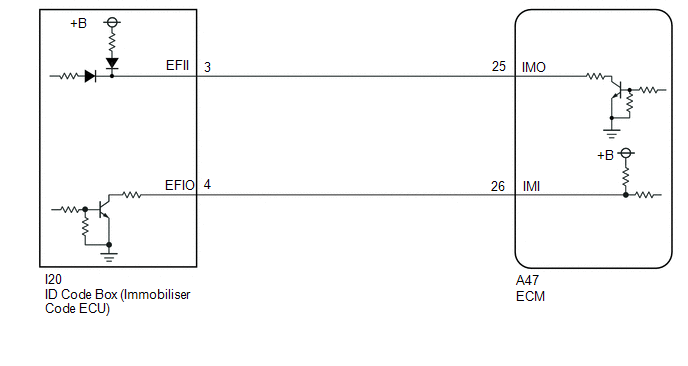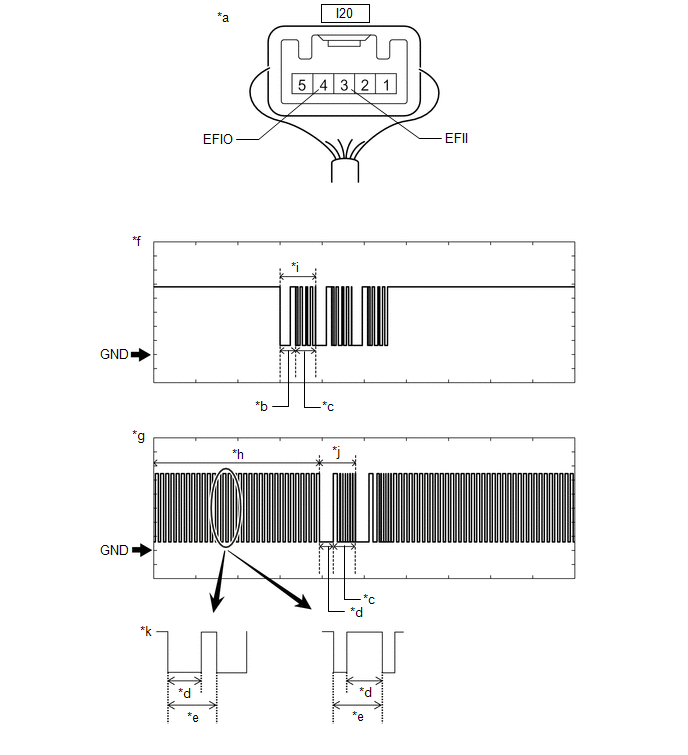Toyota Corolla Cross: Immobiliser System does not Operate Properly
DESCRIPTION
The immobiliser function compares the ID code that is registered in the certification ECU (smart key ECU assembly) with the ID code of the transponder chip that is embedded in the electrical key transmitter sub-assembly.
WIRING DIAGRAM

CAUTION / NOTICE / HINT
NOTICE:
- When using the GTS with the ignition switch off, connect the GTS to the DLC3 and turn a courtesy light switch on and off at intervals of 1.5 seconds or less until communication between the GTS and the vehicle begins. Then select the vehicle type under manual mode and enter the following menus: Body Electrical / Smart Key. While using the GTS, periodically turn a courtesy light switch on and off at intervals of 1.5 seconds or less to maintain communication between the GTS and the vehicle.
- The smart key system (for Start Function) uses the LIN communication system and CAN communication system. Inspect the communication function by following How to Proceed with Troubleshooting. Troubleshoot the smart key system (for Start Function) after confirming that the communication systems are functioning properly.
Click here
.gif)
- Before replacing the ECM or certification ECU (smart key ECU assembly), refer to Registration.
Click here
.gif)
- After repair, confirm that no DTCs are output by performing "DTC Output Confirmation Operation".
HINT:
If an immobiliser function or engine DTC is output, first perform troubleshooting for the immobiliser function or engine DTC.
PROCEDURE
| 1. |
CHECK FOR DTC |
(a) Check for DTCs.
Body Electrical > Smart Key > Trouble Codes Powertrain > Engine > Trouble Codes|
Result | Proceed to |
|---|---|
|
DTCs are not output | A |
|
DTCs are output | B |
| B |
.gif) | GO TO DIAGNOSTIC TROUBLE CODE CHART |
|
| 2. |
READ VALUE USING GTS (IMMOBILISER FUEL CUT STATUS, IMMOBILISER FUEL CUT) |
(a) Read the Data List according to the display on the GTS.
Powertrain > Engine > Data List|
Tester Display | Measurement Item |
Range | Normal Condition |
Diagnostic Note |
|---|---|---|---|---|
|
Immobiliser Fuel Cut Status |
Status of immobiliser fuel cut |
OFF or ON | OFF |
- |
|
Tester Display |
|---|
| Immobiliser Fuel Cut Status |
OK:
OFF is displayed after the engine is started.
| OK | .gif) |
|
|
| 3. |
CHECK WHETHER ENGINE STARTS |
(a) Check that the engine starts.
OK:
Engine starts normally.
| OK | .gif) | USE SIMULATION METHOD TO CHECK |
|
| 4. |
CHECK HARNESS AND CONNECTOR (ID CODE BOX (IMMOBILISER CODE ECU) - ECM) |
(a) Disconnect the I20 ID code box (immobiliser code ECU) connector.
(b) Disconnect the A47 ECM connector.
(c) Measure the resistance according to the value(s) in the table below.
Standard Resistance:
|
Tester Connection | Condition |
Specified Condition |
|---|---|---|
|
I20-3 (EFII) - A47-25 (IMO) |
Always | Below 1 Ω |
|
I20-3 (EFII) or A47-25 (IMO) - Other terminals and body ground |
Always | 10 kΩ or higher |
|
I20-4 (EFIO) - A47-26 (IMI) |
Always | Below 1 Ω |
|
I20-4 (EFIO) or A47-26 (IMI) - Other terminals and body ground |
Always | 10 kΩ or higher |
| NG | .gif) | REPAIR OR REPLACE HARNESS OR CONNECTOR |
|
| 5. |
CHECK ECM (TERMINAL EFIO AND EFII) |
(a) Connect the I20 ID code box (immobiliser code ECU) connector.
(b) Connect the A47 ECM connector.
(c) Using an oscilloscope, check the waveform.

|
*a | Component with harness connected (ID Code Box (Immobiliser Code ECU)) |
*b | Approximately 160 ms. |
|
*c | Approximately 270 ms. |
*d | Approximately 40 ms. |
|
*e | Approximately 60 ms. |
*f | Waveform (EFII) |
|
*g | Waveform (EFIO) |
*h | Waveform A |
|
*i | Waveform B |
*j | Waveform C |
|
*k | Waveform A (detail) |
- | - |
NOTICE:
The waveform shown in the illustration is an example for reference only. Noise, chattering, etc. are not shown.
OK:
|
Tester Connection | Condition |
Tool Setting | Specified Condition |
|---|---|---|---|
|
I20-3 (EFII) - Body ground |
Within 3 seconds of engine start or within 3 seconds of ignition switch turned ON after auxiliary battery cable disconnected and reconnected |
2 V/DIV., 500 ms./DIV. |
Pulse generation (See waveform (EFII)) |
|
I20-4 (EFIO) - Body ground |
Within 3 seconds of engine start or within 3 seconds of ignition switch turned ON after auxiliary battery cable disconnected and reconnected |
2 V/DIV., 500 ms./DIV. |
Pulse generation (See waveform (EFIO)) |
|
Result | Proceed to |
|---|---|
|
Normal waveform | A |
|
Waveform A or C not output, or has abnormal wavelength or shape |
B |
| Waveform B not output, or has abnormal wavelength or shape |
C |
| B |
.gif) | REPLACE ID CODE BOX (IMMOBILISER CODE ECU) |
| C |
.gif) | REPLACE ECM |
|
| 6. |
REGISTER ECU COMMUNICATION ID |
(a) Register the ECU communication ID codes.
Click here .gif)
|
| 7. |
CHECK WHETHER ENGINE STARTS |
(a) Check that the engine starts.
OK:
Engine starts normally.
| OK | .gif) | END (COMMUNICATION ID REGISTRATION WAS DEFECTIVE) |
| NG | .gif) | REPLACE ID CODE BOX (IMMOBILISER CODE ECU) |

.gif)

